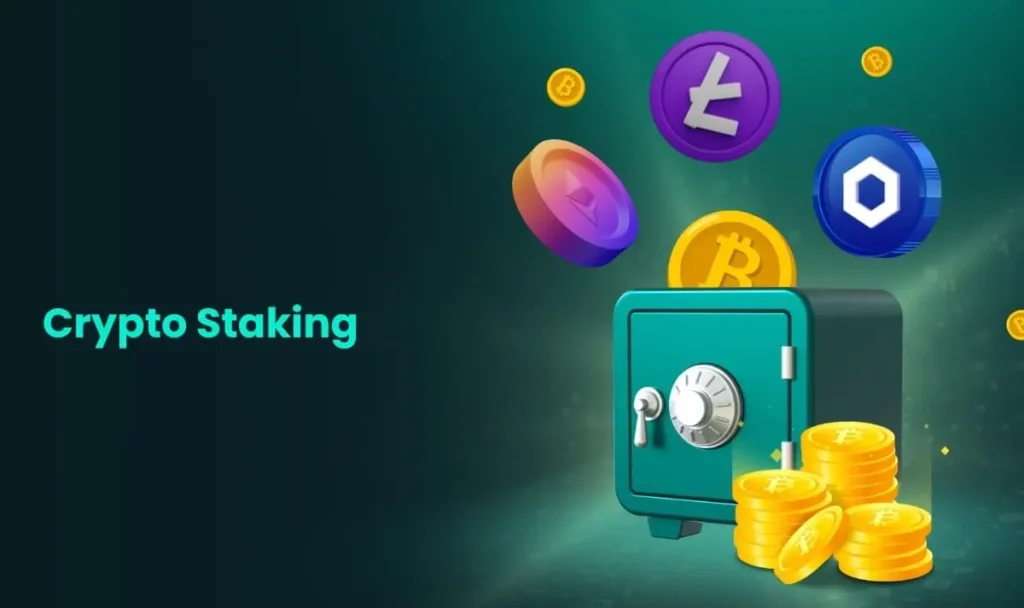If you’re into cryptocurrency, you’ve probably heard of staking. But what exactly is it, and how can it help you earn passive income? Staking is a way to make your digital assets work for you by participating in the network’s security and earning rewards in return. This guide will walk you through the basics of crypto staking, how it works, and how you can get started.

Content
What Is Crypto Staking?
In simple terms, staking is the process of holding and “locking up” a certain amount of cryptocurrency in a wallet to support the operations of a blockchain network. By doing this, you’re helping to validate transactions and secure the network. In return, you get rewarded with additional cryptocurrency, similar to how you earn interest in a traditional savings account.
Staking is mainly associated with blockchains that use a Proof of Stake (PoS) consensus mechanism, which is an alternative to the Proof of Work (PoW) system used by Bitcoin. In PoS, validators (those who stake their coins) are chosen to confirm transactions based on the number of coins they have staked, rather than solving complex mathematical problems like in PoW.
How Does Staking Work?
Staking works by locking up your cryptocurrency in a blockchain wallet. When you stake coins, you’re committing them to help the blockchain verify transactions and keep the network secure. In exchange for staking, the network rewards you with more coins. These rewards are similar to the interest or dividends you might receive in traditional finance.
Here’s a simple breakdown of how staking works:
- Select a Staking-Compatible Cryptocurrency: Not all cryptocurrencies allow staking. The most popular staking coins include Ethereum (ETH after its upgrade to PoS), Cardano (ADA), Polkadot (DOT), and Solana (SOL).
- Lock Up Your Coins: Once you’ve selected a staking coin, you can lock up a portion of your coins in your wallet or through a staking platform. Your staked coins are then used to help verify transactions on the network.
- Earn Rewards: As the network uses your staked coins to validate transactions, you’ll earn staking rewards. The more you stake, the higher the potential rewards.
- Unstaking: When you want to use your coins again, you can unstake them. However, there is often a waiting period before your coins are available to withdraw, which can range from a few days to a few weeks depending on the network.
Why Staking Is Important
Staking is important for several reasons:
- Network Security: By staking your coins, you’re helping to maintain the blockchain network. The more coins staked, the more secure the network is from attacks.
- Decentralization: Staking helps promote decentralization by allowing more participants to contribute to network security and governance.
- Passive Income: Staking provides an opportunity for cryptocurrency holders to earn passive income without needing to sell their assets.
How to Get Started with Crypto Staking
Getting started with crypto staking is easier than you might think. Here’s a step-by-step guide to help you begin:
1. Choose a Staking Coin
Not all cryptocurrencies can be staked. Staking is usually available for coins that use a Proof of Stake (PoS) or similar consensus mechanism. Some popular staking coins include:
- Ethereum (ETH): After transitioning to PoS, ETH can now be staked with a minimum of 32 ETH or through staking pools.
- Cardano (ADA): Cardano offers easy staking options and doesn’t require you to lock up your coins for long periods.
- Polkadot (DOT): DOT staking helps secure the Polkadot network and offers attractive staking rewards.
- Solana (SOL): Solana is known for its fast transaction speeds and provides an option to stake your SOL tokens.
2. Set Up a Crypto Wallet
Once you’ve chosen a staking coin, the next step is to set up a crypto wallet that supports staking. There are different types of wallets, such as:
- Software Wallets: These are apps or desktop programs where you can easily manage and stake your coins. For example, Exodus and Trust Wallet are popular options that support staking.
- Hardware Wallets: If you prefer extra security, you can use hardware wallets like Ledger or Trezor. These allow staking while keeping your private keys offline, offering more protection against hacks.
- Exchange Wallets: Many cryptocurrency exchanges, such as Binance, Coinbase, and Kraken, also offer staking services. This can be a simple way for beginners to start staking, as exchanges handle the technical side for you.
3. Choose a Staking Method
There are different ways to stake your coins depending on the network and your preferences. Here are some common staking methods:
- Solo Staking: In solo staking, you stake your coins directly through a network validator. You have full control over your coins, but this requires a deeper understanding of the staking process and often requires more significant amounts of coins (like Ethereum’s 32 ETH requirement).
- Staking Pools: For those who don’t have large amounts of crypto or prefer an easier approach, staking pools are a good option. A staking pool combines the assets of multiple participants, increasing the chances of earning rewards. This option also lowers the barrier to entry since you can stake smaller amounts.
- Exchange Staking: Many centralized exchanges offer staking services. They make it easy to stake by handling all the technical aspects, so you can just sit back and earn rewards. However, there might be higher fees, and you don’t have as much control as you would with solo staking or staking pools.
4. Start Staking and Earning Rewards
After setting up your wallet and choosing a staking method, you’re ready to start staking. Your rewards will depend on several factors, including:
- Amount Staked: The more you stake, the higher the potential rewards.
- Staking Duration: Some networks reward long-term staking more generously, so holding your coins in a stake for extended periods can result in higher returns.
- Network Conditions: Reward rates vary depending on the number of people staking and the network’s reward mechanism.
Rewards are usually paid out in the form of the cryptocurrency you’re staking. For example, if you stake Cardano (ADA), your rewards will be in ADA.
Risks of Crypto Staking
While staking can be a great way to earn passive income, it’s important to be aware of the potential risks:
- Price Volatility: Cryptocurrencies are known for their price volatility. The value of the coins you’re staking may fluctuate significantly, which could affect your overall returns.
- Lock-Up Periods: Some networks require you to lock up your coins for a specific period, during which you can’t access or sell them. This could be a disadvantage if you need immediate liquidity.
- Slashing: Some PoS networks penalize validators (and sometimes delegators) for malicious behavior or technical errors. This process, known as “slashing,” can lead to a loss of a portion of your staked funds.
Is Crypto Staking Worth It?
Crypto staking can be a great way to earn passive income, especially if you’re holding coins that would otherwise just sit in your wallet. If you’re a long-term investor in a PoS cryptocurrency, staking allows you to put your assets to work while contributing to network security. However, as with any investment, it’s important to research thoroughly and understand the risks before diving in.
Conclusion
Crypto staking is an innovative way to earn passive income by locking up your digital assets in a decentralized network. By participating in staking, you not only secure the blockchain but also earn rewards for doing so. Whether you’re a beginner or an experienced crypto holder, staking offers a unique opportunity to grow your cryptocurrency holdings without needing to actively trade.

Martin Wilson has been following the crypto space since 2013. He is a passionate advocate for blockchain technology, and believes that it will have a profound impact on how people live their lives. In addition to being an avid blogger, Martin also enjoys writing about developments in the industry as well as providing useful guides to help those who are new to this exciting frontier of finance and technology.
